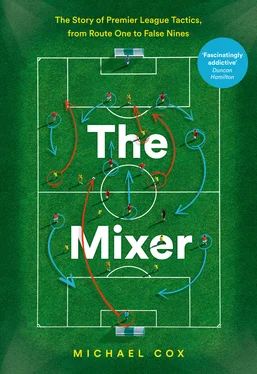This book seeks to explain how. Although the 25 years are represented by 25 chapters, this is a thematic rather than a literal season-by-season account. The focus is upon the revolutionaries: the innovative managers, the game-changing players, the inspirational teams, the new tactical concepts, the off-field developments that influenced playing styles. The story is about the Premier League becoming universal, in two different ways.
First, it became universal on a tactical level. In the early 1990s there were very specific demands for every position – defenders simply defended, attackers simply attacked. But gradually positions became more all-encompassing, with defenders expected to start attacking moves and attackers encouraged to start defensive pressure. Players were increasingly all-rounders rather than specialists.
Second, it also became universal on a geographical basis, as English clubs broadened their horizons and became increasingly dependent upon foreign players and managers. Amazingly, on the Premier League’s opening weekend in August 1992, just 11 foreign players started for the 22 clubs combined, and there were no foreign managers. By its 25th season, the majority of Premier League players and managers were foreign – and almost every major footballing nation on earth was represented. Of the top 25 countries in the FIFA rankings, only Mexico didn’t have a Premier League representative in 2016/17.
The combination of these two factors saw Premier League sides abandon ugly, straightforward, direct football and embrace a more cultured, continental, technical style. This is the story of the Premier League’s remarkable tactical evolution – from pie to paella, from route one to false nines.
Part One
In the Beginning
1
‘The back-pass law is the best rule change ever – it has changed the game.’
Peter Schmeichel
We are constantly reminded that ‘football didn’t start in 1992’ in response to Premier League-centric historical records, but 1992 effectively marked the beginning of modern football. It was the beginning of a new, exciting, more entertaining era of the game, the watershed moment that prompted sweeping changes to create a more fast-paced, technically proficient sport.
However, it had absolutely nothing to do with the formation of the Premier League.
The introduction of the back-pass law in 1992 had a transformative effect upon football. Not since 1925 – when the offside law was altered so that only two opponents, rather than three, needed to be goalside of an attacker – had a law change been so effective at improving the spectacle of the world’s most popular sport. There have been minor alterations to the Laws of the Game during the Premier League era: different interpretations regarding offside, stricter laws governing tackles, revisions to kick-off. But 1992 was literally a game-changer.
The law change was simple. Previously, goalkeepers were allowed to use their hands if the ball was deliberately kicked to them by a teammate. Now, they were not. They could still handle the ball if a teammate headed, chested or even kneed it back, and throw-ins back to the goalkeeper could be picked up until 1997, but goalkeepers were forced to use their feet more than ever before, effectively becoming part of passing moves.
There was an extremely good reason for the law change. Hitherto, teams could time waste infuriatingly when leading matches; the goalkeeper would roll the ball out, the defenders would retain possession until an opponent challenged, then return the ball to the goalkeeper, who would pick it up and restart the process. It was often very tedious, and in hindsight it’s incredible that any team ever contrived to lose a lead. The ultimate example came in the dying seconds of Rangers’ European Cup first round tie against Dynamo Kiev in 1987. With Rangers 2–1 ahead on aggregate and building an attacking move, midfielder Graeme Souness received the ball midway inside the opposition half, immediately turned towards his own goal and thumped a 70-yard backward ball to his goalkeeper Chris Woods. Souness, incidentally, would later suffer from the back-pass change more than most.
Examples of negative play became particularly obvious at the 1990 World Cup, a tournament so dreadfully negative that FIFA felt compelled to take action. The new law came into effect two years later, in time for the inaugural Premier League campaign.
While some managers, like Luton Town’s David Pleat, spoke in favour of the change, there was a significant backlash from most top-flight managers, including the last two title-winning bosses. ‘I don’t think this is going to enhance the game at all,’ complained Arsenal’s George Graham, while Howard Wilkinson, who had taken Leeds United to the final pre-Premier League title in 1991/92, suggested the new laws would simply encourage long-ball football. ‘If the new rule is the authorities’ idea of how to foster better football, then the experiment will prove counter-productive,’ he declared. ‘The new ruling will be manna from heaven to a coach working with his long-ball side.’
Wilkinson predicted teams would concentrate on pumping long balls in behind the opposition and use a ‘goalie-blocker’, lingering in an offside position, to intercept potential back-passes from defenders to the goalkeeper’s feet, forcing them to hack the ball into touch instead. ‘FIFA have inadvertently encouraged more long-ball football,’ he maintained. ‘This isn’t a mad, scientific nightmare, this is the reality as stipulated by the overlords of the world game.’ Wilkinson’s view, that route one football would become dominant, found support from many managerial colleagues.
But the back-pass law served its initial purpose, and teams were no longer able to time waste so blatantly. Wilkinson’s predictions about long-ball football weren’t entirely inaccurate immediately following the law change – Leeds’s matches in a pre-season friendly tournament against Stuttgart and Sampdoria were notable for the opposition repeatedly playing hopeful balls in behind the Leeds defence, hoping for errors – but he failed to foresee how goalkeepers and defenders would adjust and gradually become comfortable in possession, creating a more technically advanced sport.
There were significant knock-on effects. Teams had a greater incentive to press in advanced positions, forcing defenders into mistakes, and managers were less inclined to play stiflingly aggressive defensive lines, because covering the space in behind now involved playing out of trouble. As a result the game became stretched, which created more room in midfield. Arguably the biggest change was in the speed of matches – players had previously become accustomed to breaks in play while goalkeepers held onto the ball. Suddenly the action had become non-stop.
These developments, the consequence of one simple law change, played into the hands of the Premier League, a division created specifically to provide televisual entertainment. Sky Sports introduced plenty of innovations, including a simple idea that has become universally established: displaying the score and clock on the top-left of the screen. Other Sky gimmicks were less successful: pre-match firework displays were scrapped after a stray rocket was launched out of The Dell and into a nearby petrol station, while the use of cheerleaders was short-lived, possibly after concerns from the presenter over their understanding of the offside rule. But none of this artificial razzmatazz was as crucial as the back-pass law in making the Premier League a fantastic show, and Sky were hugely fortunate that world football took an enormous step forward ahead of 1992/93. Without this significant improvement in the spectacle of matches, the Premier League wouldn’t have developed into the multi-billion-pound product it is today.
Читать дальше












